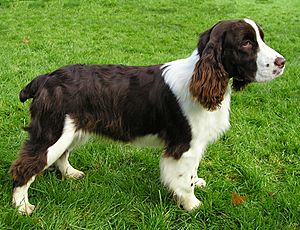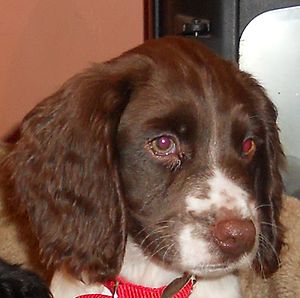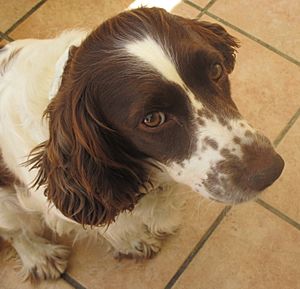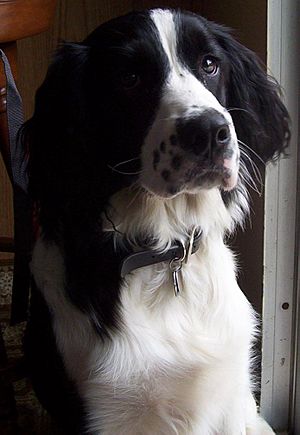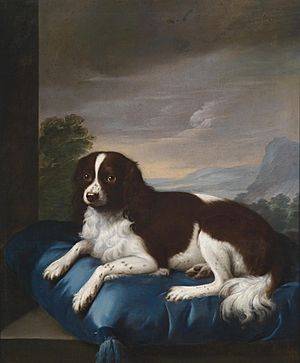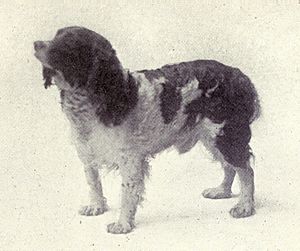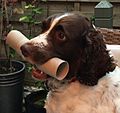English Springer Spaniel facts for kids
 |
||||||||||||||||||||||||||
| Other names | Springer Spaniel | |||||||||||||||||||||||||
|---|---|---|---|---|---|---|---|---|---|---|---|---|---|---|---|---|---|---|---|---|---|---|---|---|---|---|
| Origin | England | |||||||||||||||||||||||||
|
||||||||||||||||||||||||||
| Domestic dog (Canis lupus familiaris) | ||||||||||||||||||||||||||
The English Springer Spaniel is a type of dog breed that people use as hunting dogs. They help find and bring back animals. This breed is one of many spaniel types. English Springers are known for being smart and happy dogs. Their fur can be brown and white, black and white, or have tan spots. They look a bit like their relatives, the Welsh Springer Spaniel and Cocker Spaniel.
Contents
About English Springer Spaniels
The English Springer Spaniel is a medium-sized dog. It has a compact body and a coat that is not too long. Their fur is a bit longer on their legs and tail, which is called "feathering." They are well-balanced dogs with a kind look and a friendly, wagging tail.
Types of English Springers
There are two main types of English Springer Spaniels: those bred for hunting (called "field-bred") and those bred for dog shows (called "show-bred").
- Field-bred dogs usually have shorter, rougher coats. They look more athletic and are chosen for their great sense of smell and hunting skills. Their tails might be shorter.
- Show-bred dogs have longer, thicker fur. Their tails are often made shorter in places where this is allowed. These dogs are generally heavier and have stronger bones than field-bred Springers.
How They Compare to Other Spaniels
The English Springer Spaniel looks similar to the English Cocker Spaniel. The main difference is that Cocker Spaniels are smaller. English Springers also have shorter ears that are set higher on their heads. Their noses are longer, their eyes are not as big, and their fur is not as thick as a Cocker's.
The Welsh Springer Spaniel is also similar. However, Welsh Springers usually come in fewer colors and are a little smaller than English Springers.
Coat Colors and Sizes
English Springer Spaniels shed their fur mostly in summer and spring. Sometimes they shed a little in autumn too. Their coats come in different colors:
- Black or dark brown (liver) with white markings.
- Mostly white with black or liver markings.
- Tricolor: black and white or liver and white with tan spots. These tan spots are usually on their eyebrows, cheeks, inside their ears, and under their tail.
- Any white part of their coat might have small flecks of color, called "ticking."
Male English Springers bred for shows are usually about 18 to 20 inches (46 to 51 cm) tall at the shoulder. They weigh about 50 to 55 pounds (23 to 25 kg). Females are typically 17 to 19 inches (43 to 48 cm) tall and weigh 35 to 45 pounds (16 to 20 kg). Working dogs can be a bit lighter and have finer bones.
English Springer Spaniel Temperament
English Springers are usually friendly dogs. They love to please their owners, learn quickly, and are happy to follow commands. If they are in the right home, they can be loving and easy-going family pets. Their alertness makes them great hunting partners. A Springer Spaniel often picks one person in the family to be most loyal to. They will try to stay close to that person as much as possible.
This breed is very smart. They need a good amount of activity to keep their minds busy and to get exercise. Each dog is different, but they generally have a lot of energy. Their long legs make them one of the fastest spaniel breeds.
English Springers are social dogs. They usually get along well with children and other pets. However, hunting-bred Springers might not always get along with cats. If left alone for too long, they can get bored and become destructive. They also love water and will often try to get wet whenever they can!
Health of English Springer Spaniels
English Springer Spaniels typically live for about 10.5 to 15 years. They can gain weight easily, so owners need to be careful about how much food they eat.
History of the Breed
The history of spaniels goes back a long time. In 1576, an English doctor named Dr. John Caius wrote a book about British dog breeds. He was the first to describe different types of spaniels based on what they did. By 1801, people started to divide land spaniels into two groups: the "Springing Spaniel" (or Starter) and the "Cocking Spaniel" (or Cocker Spaniel).
At that time, both Cocker Spaniels and Springer Spaniels could be born in the same litter of puppies. They were all used for hunting. The smaller Cocker Spaniels were used to hunt small birds like woodcock. The larger Springer Spaniels would "spring" or "flush" (make jump out) gamebirds into the air. Then, a trained falcon or hawk would catch the bird and bring it to the hunter.
Many spaniel breeds were developed in the 1800s. They were often named after the areas where they were bred. Two types of larger land spaniels were very popular: the Norfolk and Shropshire spaniels. By the 1850s, these were shown as "Norfolk spaniels."
Hunting Skills
The English Springer Spaniel is mainly an upland flushing dog. This means they help hunters find birds in fields and forests. Breeders train these dogs to do many special things for hunting:
- Bringing Game to Hand: Dogs are trained to bring the bird directly to the hunter's hand.
- Soft Mouth: Springers are taught to carry game gently without biting or damaging it. The bird should be good to eat after the dog brings it back.
- Quartering: The dog works in a zig-zag pattern in front of the hunter. They search for birds and stay close enough for the hunter to shoot.
- Scenting: A good Springer can smell game in both wet and dry weather. They learn to use the wind to find birds.
- Flushing: When a Springer finds a bird, it should make the bird fly up without hesitation.
- Hup: This is a command for the dog to sit and stay. This helps the hunter keep up with the dog.
- Following Hand Signals: Hunters use hand signals to tell the dog where to go and search for birds.
- Steady: When a bird flies up or a gun is fired, the dog should sit down. This helps them remember where the bird fell and prevents them from scaring other birds.
- Blind Retrieve: A well-trained Springer can be guided by hand signals and whistles to find a bird that the hunter didn't see fall.
English Springer Spaniels as Detection Dogs
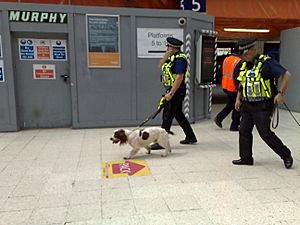
English Springer Spaniels are also used as sniffer dogs. They have a very good sense of smell, which makes them great at finding things.
- Buster was a famous Springer Spaniel. He was a search dog for the Royal Army Veterinary Corps. He found hidden weapons and explosives in Iraq and received a special medal called the Dickin Medal.
- Jake was another brave Springer Spaniel. He was an explosives search dog for the London Metropolitan Police. He helped after the 7 July 2005 London Bombings.
Springers can find more than just explosives. A male Springer named Murphy was trained to find mobile phones in a prison. He could even tell the difference between guards' phones and illegal phones hidden by prisoners. Other Springers have been used to sniff out bumblebee nests, illegal immigrants, and even blood. They are used for drug detection in many countries, including the United Kingdom, Sweden, Finland, Canada, and Ireland.
Images for kids
See also
 In Spanish: Springer spaniel inglés para niños
In Spanish: Springer spaniel inglés para niños


